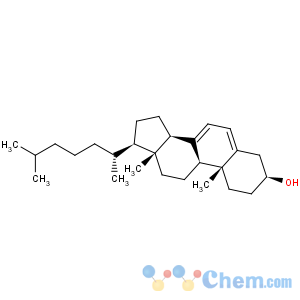7-Dehydrocholesterol
-

Molecular Structure
Detailed Description
Product Name: 7-Dehydrocholesterol
Synonyms: (3)-7-Dehydrochlesterol;(3beta)-Cholesta-5,7-dien-3-ol;(3-beta)-cholesta-7-dien-3-ol;(3beta)-cholesta-7-dien-3-ol;3-Hydroxycholesta-5,7-diene;5,7-Cholestandien-3.beta.-ol;5,7-Cholestandien-3beta-ol;7,8-Didehydrocholesterol
Product Details:
Place of Origin: China
Certification: ISO9001
Brand:YuanCheng
Payment & Shipping Terms:
Minimum Order Quantity:1kg
Supply Ability:500kg/month
Delivery Time:within 24 hours after payment
Payment Terms:Western Union, MoneyGram, T/T
Appeatance:white to off-white fine crystalline powder
Package:25kg/bucket
Purity:95%
Product Description:
CAS: 434-16-2
MF: C27H44O
MW: 384.64
EINECS: 207-100-5
7-Dehydrocholesterol is a zoosterol that functions in the serum as a cholesterol precursor, and is converted to vitamin D3 in the skin, therefore functioning as provitamin-D3. The presence of this compound in human skin enables humans to manufacture vitamin D3 from ultra-violet rays in the sun light, via an intermediate isomer pre-vitamin D3. It is also found in the milk of several mammalian species. In insects it is a precursor for the hormone ecdysone, required for reaching adulthood.It was discovered by Nobel-laureate organic chemist Adolf Windaus
Synthesis of pre-vitamin D3 in the skin involves UVB radiation which effectively penetrates only the epidermal layers of skin. 7-Dehydrocholesterol absorbs UV light most effectively at wavelengths between 290-320nm and thus the production of vitamin D3 will only occur at those wavelengths. The two most important factors that govern the generation of pre-vitamin D3 are the quantity (intensity) and quality (appropriate wavelength) of the UVB irradiation reaching the 7-dehydrocholesterol deep in the stratum basale and stratum spinosum.[4] Another important consideration is the quantity of 7-dehydrocholesterol present in the skin. Under normal circumstances, ample quantities of 7-dehydrocholesterol (about 25-50 mg/cm2 of skin) are available in the stratum spinosum and stratum basale of human skin to meet the body's vitamin D requirements.
Usage:
1. Important intermediate in the synthesis of vitamin D3
2. Skin sunscreen additive in cosmetics
3. Other laboratory reagents
ychz01(at)yccreate dot com

- 7-Dehydrocholesterol




